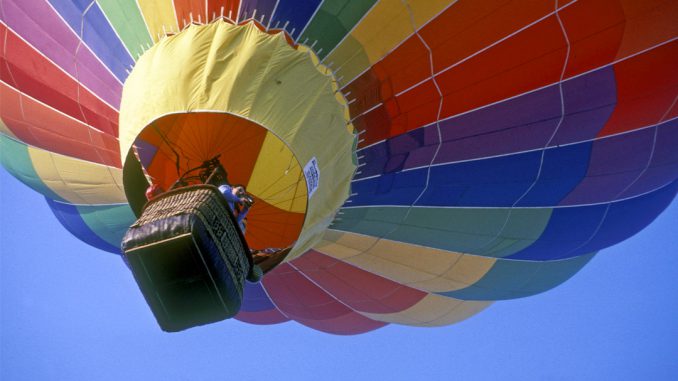
Escape the mundane by including an aquatic, aerial or terrestrial adventure in your next vacation
Age is no barrier to adventure. When we look back on our travels, the adventurous pursuits are often the highlights.
Our most memorable experience was a surreal descent down the Cayman Wall. As the pilot propelled our two-passenger yellow submersible down 305 metres, we gazed through a circular window at multicoloured sponges and strange life forms.
The most bizarre were the stalked crinoids, which have heads resembling exploding fireworks on long stalks. When food becomes scarce, they lift their feet from the silt and use their feather-like arms to pull themselves to locations with more plankton. We felt as if we were on another planet.
More close encounters of the deep kind
Although Atlantis Submarines no longer offers two-person submersible tours, the company now operates undersea voyages on 48- and 64-passenger submarines in the Caribbean, Mexico, Guam and Hawaii. Riders peer through portholes as the pilot describes the dazzling marine life at depths of up to 40 metres.
During our Barbados underwater tour, the branching coral and aquatic life viewed through our circular windows seemed close enough to touch. We came eye-to-eye with iridescent reef fish and practically rubbed noses with a green turtle. Each porthole has an attached card with pictures of tropical fish for easy identification.
Our 45-minute journey ended far too quickly.
Diving without snorkels & scuba gear
Even if you don’t swim, Hartley’s Undersea Walk in Bermuda offers Jacques Cousteau wannabes – including children, seniors and disabled individuals – the opportunity to closely examine sea cucumbers, giant hogfish and other aquatic life.
During our undersea walk, we breathed fresh air pumped into diving helmets that crew members placed on our shoulders. (Participants can wear glasses because their heads remain dry.)
As we walked along the sandy ocean floor, Hartley pointed out breathing holes in antler and tube sponges. Fish flickered their fins and swished their tails tauntingly in front of our dive helmets’ windows. Hartley later told us about a large grouper that nestled into the arms of a visually impaired man, allowing him to feel its whole body.
Helmet diving is an awesome experience for all ages and abilities.
Kayaking with sea otters
In California’s Monterey Bay National Marine Sanctuary, we rented kayaks to watch the bay’s endearing, bewhiskered sea otters.
A brown head popped up near our kayak and surveyed us with his button eyes. Another otter nonchalantly floated on his back, munching an abalone.
Otters carry tools, such as rocks, under their arm-flaps and pull them out to crack open shellfish. After they eat their meals, using their midriffs as tables, they turn their torsos over in the water to clear away the crumbs.
Another otter surfaced with a crab, disassembling and eating one leg at a time, before twirling the crab like a donut to gnaw at the edges. A seagull descended on his belly to snatch some tasty tidbits.
We remember our delight every time we look at our photos.
Travelling with the wind
The mass ascension of more than 500 hot-air balloons at New Mexico’s Albuquerque International Balloon Fiesta was our first experience with lighter-than-air flight. Our anticipation surged as the pilot and crew inflated the balloon with propane burners. Bold patterns and vivid splashes of nylon billowed out like butterflies emerging from cocoons.
Crew members restrained the inflated balloon from ascending as we scrambled into the gondola with the pilot and other passengers. With a whoosh of the propane burner, we were up, up and away!
We felt no motion. Below us, the landscape scrolled by, with houses and cars no larger than toys.
Landings are as exciting as launches. On another flight over California’s Napa Valley vineyards, a wind gust forced our pilot to descend in an alternative location.
Balloon descents always draw onlookers. A man wearing only running shoes and a baseball cap rushed out to greet us. “You’ve just landed in a private nudist camp,” he said.
Our pilot grinned and fired the propane burners to propel us to another site. This time, we landed in a churchyard, just as the wedding party was leaving the church. The bride and groom joined us for the traditional after-flight champagne toast.
Imagining that you’re the Red Baron
After we booked a Fort Myers, Florida biplane ride, our pilot Doug offered us the choice of a sightseeing flight or a barnstorming option. We selected the sightseeing tour, with a sample aerobatic stunt.
Donning dog-eared caps and goggles, we sat side by side in the open cockpit in front of Doug in his replica 1935 WACO biplane. We expected ear-deafening noise, bugs in our teeth and wind in our faces as we became airborne, but it was surprisingly calm behind the windshield.
We glided over Cape Coral’s canals, Matlacha’s mangroves and fruit plantations near Pine Island.
“Look over the left-wing tip!” said Doug through the two-way intercom attached to our caps. Below us, dolphins jumped merrily in Captiva Pass.
As we viewed Sanibel Island through the struts of our double-winged plane, people waved to us from crayon-coloured kayaks below. “Let’s wave back,” said Doug, as he rocked the wings up and down.
We felt like barnstormers when Doug revved the engine for a steep climb. G-forces pushed us back into our seats. Exhilarated, we resolved to experience some rolls, figure eights and steep turns on our next biplane flight.
Motorless flight
The biplane ride motivated us to soar in motorless planes from the Seminole‑Lake Gliderport in Clermont, Florida. To enhance our viewing, each of us sat in front of our pilots in two-seat gliders.
“Gliding is safe because there are no engines to fail,” they explained, prior to the flights. “You don’t need wind to stay aloft – just sunlight to heat up the ground, creating thermals which we follow up and down.”
After tow-planes pulled the gliders up a kilometre high, the pilots disconnected the ropes with a clunk. Silence followed as we spiralled through blue skies and puffy clouds.
Gently holding the sticks in front of us, we followed the maneuvers of our pilots. They banked tightly above forested landscapes and then rotated the gliders so that the wings were at 90-degree angles to the ground. We found ourselves looking straight out of the canopies at orange groves, rather than the sky.
The wing‑overs were the highlights of our flights. After our gentle landings, we emerged from the gliders on Cloud Nine.
Playing Tarzan
As we slid through the Costa Rican forest on a zipline, 45 metres above the ground, we understood how Tarzan felt as he swung through the jungle on a liana vine.
We just had to work up the courage to take that first step off the platform.
Canopy tours consist of ziplines strung between platforms attached to tall trees. Our guide Diego connected safety ropes to our climbing gear before we ascended the ladder to the first wooden platform. From here, the second platform in the arms of a huge strangler fig looked very far away.
“There’s no turning back now,” said Diego, as he demonstrated how to control our speed by using leather gloves to grip the cable behind the pulley attached to our harnesses.
The scenery dissolved in a green blur, as we whizzed across to the next two platforms. At the third platform, we had to muster up the courage to rappel 45 metres down a huge kapok tree.
After stepping off, we realized that we weren’t falling. We gripped the ropes behind our backs to control our descent rate and enjoyed the transition from the forest canopy to the ground.
Tarzan would be proud of us.
Rent-a-camel
When it comes to exotic adventures, few experiences can match a camel trek. In Tunisia, we joined other travellers on a tour offered by a camel-rental agency.
Led by their caretakers, the camels plodded past sand dunes to a palm tree-studded Sahara oasis. Our excursion was in the late afternoon, when the sun stretched the shadows of camels and riders across the sand.
Traversing the desert is like watching a movie in slow motion. As we observed women with tattooed faces, turbaned shepherds watering sheep at artesian wells and Berber tents punctuating the sandscape, we felt as if we were actors in a biblical epic.
Walking safari
We felt vulnerable outside of our vehicle when we began our Botswana foot safari. “If we meet unexpected wildlife, stay in a single file so that animals see us as a large unit,” advised our guide Gavin.
“If elephants appear, back off slowly. If lions threaten us, stay rock steady. They’ll chase you if you run, because you’re acting as prey.”
Gavin pointed to some elephant tracks in the sand. Each footprint was so massive that the two of us could stand in it.
We approached several giraffes that were plucking acacia leaves from the treetops with their long tongues. A male kudu with a magnificent set of spiralled horns eyed us from a herd of these donkey-sized antelopes.
After encountering them and other grazing animals, including waterbucks and zebras, a sense of awe replaced our initial susceptibility.
Piranha fishing
Razor-toothed piranhas can reputedly reduce their victims’ bodies to skeletons in minutes. Our Amazon fishing guide Marco attempted to reduce our trepidation.
“Not all species of piranha in the Amazon are carnivorous,” he said, but we were skeptical as we watched our boatman chop chunks of bloody, red beef for bait. Within minutes of tossing our baited hooks overboard, we pulled up several small, but feisty, red-bellied piranhas. Marco carefully removed each fish and impaled it on a stick.
He explained that we were travelling over a flooded forest. “Between January and June, Andes meltwater overflows the riverbanks and covers the trees. Fish gorge themselves on submerged fruits. Because the piranhas have full tummies, they’re not dangerous.”
When the water recedes in the dry season, many fish are trapped in small pools without food. “This is when they’ll attack animals and humans,” said Marco.
To our surprise, he jumped into the water for a swim. He emerged unmolested, but his splashing scared away the piranhas.
We gave our catch to the boatman to bring home for dinner. “They’re delicious, but we eat them with our fingers to feel for tiny forked bones that can lodge in the back of our throats,” he said.
Even cooked piranhas can be dangerous.
Climbing an active volcano
Looking over a concrete barrier, we gasped at the sight of a hole that was so enormous it could swallow three Roman coliseums. As the orifice belched white clouds of sulphur gases towards us, we and dozens of onlookers simultaneously coughed.
Located in Nicaragua’s Masaya Volcano National Park, the 635-metre-high Santiago crater has been permanently active since 1946. Black lava fields from Masaya’s first eruption in 1772 frame a paved road to the crater’s edge.
From here, we climbed 184 steps to a lookout to view the glowing lava below. Santiago’s 500-metre-wide crater dwarfed the buses and cars in the adjacent parking lot.
We weren’t surprised to learn that the Spaniards erected a giant cross at the summit in 1529 to exorcise the devil. They believed that the crater was the entrance to hell.
Consider adding these adventures or other thrilling experiences to your next trip. When friends or family ask what you did on vacation, you’ll enthrall them with something more captivating than relaxing on the beach.
Barb & Ron Kroll publish the trip-planning website www.KrollTravel.com
